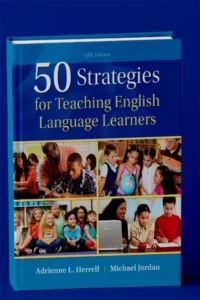50 Strategies for Teaching English Language Learners includes a rich assortment of practical strategies aligned to TESOL standards, which have been field-tested in diverse classrooms.
50 Strategies for Teaching English Language Learners
Each strategy in this book includes a brief explanation, step-by-step instructions on how to plan and use the strategy, and classroom scenarios demonstrating how the strategy can be adapted for different grade levels and content areas.
The authors have included additional strategies in language and literacy development, technology, and assessment to support both pre-service and in-service teachers.
The Fifth Edition represents a major change in standards-based education that helps educators meet the additional challenges of the Common Core State Standards in the process of acquiring English.
Included are six new strategies,
- self-evaluation rubrics,
- adaptation charts,
- classroom examples demonstrating approaches to CCSS,
- video links, pop-ups encouraging further reading,
- and a glossary of terms encountered in the text.
WHAT’S NEW IN THE SECOND EDITION?
This edition is organized to serve as a resource book, not just a text. The book is arranged in five sections.
Section I: Theoretical Overview supports the teacher in understanding the basic principles of teaching and assessing English learners.
Section II: Strategies for Enhancing Instruction through Planning gives suggestions of ways to integrate the basic principles addressed in Section I into effective classroom lessons. This section focuses on the adaptations necessary in making ordinary lessons extraordinary’ in helping ELL students understand the content being taught and acquire the English necessary for successful participation in English-only classrooms. The last three sections in the book address specific learning goals.
Section III: Strategies for Supporting Student Involvement supports the teacher in ensuring active participation by all students. This is an important factor in enhancing the success of English learners in the classroom.
Section IV: Strategies for Building Vocabulary and Fluency gives a number of vocabulary and fluency-building approaches.
Section V: Strategies for Building Comprehension completes the text by providing active-learning approaches to helping students make sense of the instruction and readings they encounter. Each section begins with easy-to-implement strategies and progresses to more involved approaches. It should be noted that all 50 strategies have been thoroughly field-tested in highly diverse classrooms in California, Florida, and Alaska.


